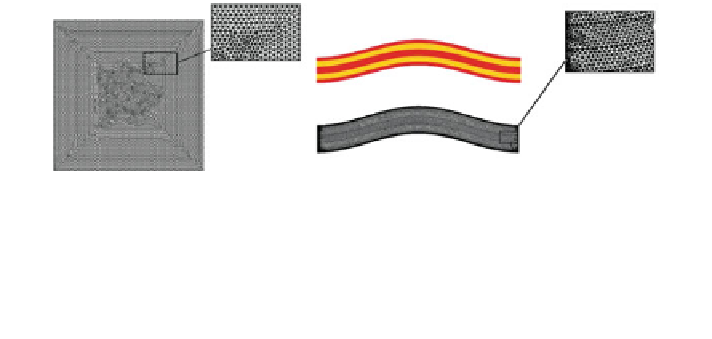Biomedical Engineering Reference
In-Depth Information
Macroscale Model
Microscale Model
Fig. 11 Micromechanical stress and strain localization of tendon [
156
]. A macroscale model
consisting of a cube of tendon tissue (mesh shown on left) was subjected to simulated loading and
the macroscale deformation was computed. This deformation was then applied to the microscale
model (right). The microscale model consisted of fibers (shown on the upper right in red)
connected via an inter-fiber matrix (shown in yellow). A closeup of the macroscopic and
microscopic model mesh is shown in the breakout boxes. Figure adapted from [
156
]
crimp angle, helical twist, the number of fibrils and the stiffness of the fibrils and
matrix suggested that the large Poisson's ratios were predicted across a range of
physiologically relevant values for these parameters. This study highlights the
utility of homogenized micromechanical models in testing structure function based
hypothesis that are otherwise difficult to address. Furthermore, it demonstrates the
use of 3D until cells with a non-rectangular cross section for the use of nonlinear
homogenization.
In the previously discussed studies, boundary conditions on the microme-
chanical model were applied a priori to the microscale models. In a recent study,
micromechanical models were combined with a macroscale simulation to solve the
localization problem [
156
]. In a localization problem, a macroscale deformation
(generally computed from a continuum based FE simulation) is applied to an RVE,
which is then solved in order to obtain the microscale stress and strain [
122
]. In
this study, an analytically based homogenization was used as the constitutive
model for a macroscopic FE simulation. Briefly, the analytical homogenization
modeled collagen crosslinks at the nanoscale and collagen fiber uncrimping at the
microscale to specify a macroscopic continuum response. The homogenization
was not based on an explicit microstructural organization, therefore no microscale
strains were computed. A macroscale cube was subjected to a tensile loading
(Fig.
11
, left), which yielded a macroscale deformation within each element. This
macroscale deformation from an element in the interior of the macroscale mesh
was applied to a microscale RVE (Fig.
11
, right), which was solved using an FE
simulation. The microscale FE results revealed a heterogenous distribution of
stress and strain at the microscale. Although this study was primarily the pre-
sentation of a new method, it demonstrates the utility of micromechanical models
in solving the localization problem by applying the results of a macroscale sim-
ulation to a microscale RVE.
The aforementioned models were limited to quasistatic elastic simulations only.
However, models that can incorporate the time dependence and biphasic nature of
these tissues are desirable. In one study, a macroscopic biphasic FE model was

Search WWH ::

Custom Search